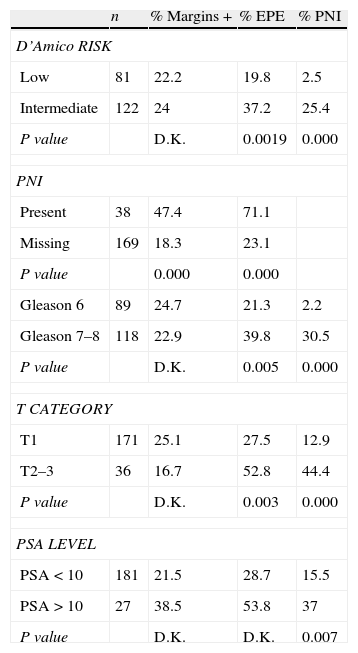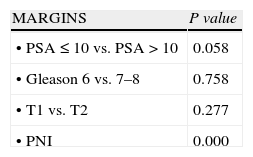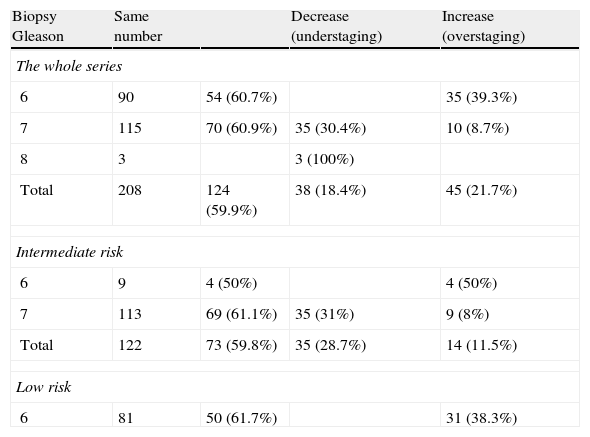Despite tumor cell dissemination through the intraprostatic nervous system being considered as a prostate cancer progression mechanism, the significance of perineural invasion in prostate biopsies to predict extraprostatic extension and its use as a potential prognosis factor is controversial.
Materials and methodsRetrospective study carried out at an institution on 208 patients treated with radical prostatectomy (January 2007–July 2010) in which the presence of perineural invasion and the Gleason score in the preoperative biopsy were determined, as well as the clinical stage and the pre-surgery PSA. We classified the patients in risk groups in accordance with the D’Amico classification. We performed bivariate and multivariate statistical analyses to establish the correlations between the different variables.
ResultsWe objectified PNI in 18.3% of the prostate biopsies. 71% of the prostatectomy specimens with perineural invasion presented extraprostatic extension in the previous biopsy against 23.1% when this was not found (p<0.0001) and 47% of the cases showed positive margins with PNI, against 18.3% without perineural invasion (p<0.0001). In fact, in the multivariate analysis, perineural invasion proved to be an independent risk factor in the presentation of extraprostatic extension and positive margins in the prostatectomy specimen.
ConclusionsThe presence of perineural invasion is a useful prognostic factor for predicting extraprostatic extension and the involvement of surgical margin in the radical prostatectomy specimen. We believe that determining it may be a useful tool for improving preoperative diagnosis and planning treatment.
A pesar de que la diseminación celular tumoral a través del sistema nervioso intraprostático se considera un mecanismo de progresión del cáncer prostático, el significado de la invasión perineural en biopsias de próstata para predecir extensión extraprostática y su utilidad como potencial factor pronóstico es controvertido.
Material y métodosEstudio retrospectivo llevado a cabo en una institución sobre 208 pacientes tratados con prostatectomía radical (enero 2007-julio 2010) en los que se ha determinado la presencia de invasión perineural y el score de gleason en la biopsia preoperatoria, así como el estadio clínico y el PSA prequirúrgico. Clasificamos los pacientes en grupos de riesgo según la clasificación de D’Amico. Realizamos análisis estadístico bivariante y multivariante para establecer la correlación entre las distintas variables.
ResultadosSe objetivó IPN en el 18,3% de las biopsias prostáticas. Presentaron extensión extraprostática el 71% de los espécimenes de prostatectomía con invasión perineural en la biopsia previa vs. 23,1% cuando no existía este hallazgo (p<0,0001) y márgenes positivos el 47,4% de los casos con IPN, frente a 18,3% sin invasión perineural (p<0,0001). De hecho, en el análisis multivariante la invasión perineural demostró ser un factor de riesgo independiente para presentar extensión extraprostática y márgenes positivos en la pieza de prostatectomía.
ConclusionesLa presencia de Invasión perineural es un factor pronóstico útil para la predicción de extensión extraprostática y afectación de márgenes quirúrgicos en la pieza de prostatectomía radical. Consideramos que su determinación puede ser una herramienta útil en la mejora del diagnóstico preoperatorio y en la planificación del tratamiento.











